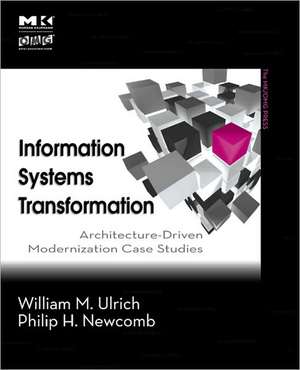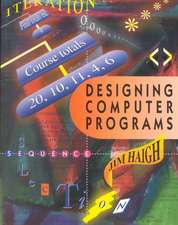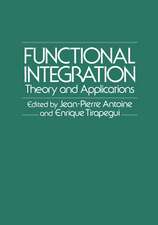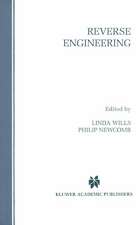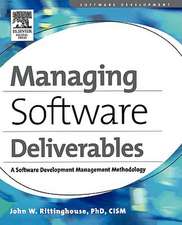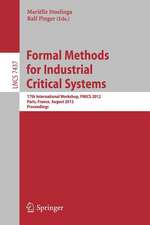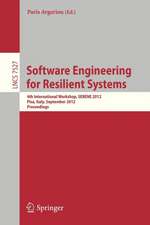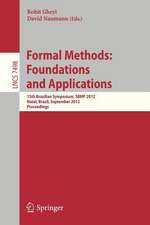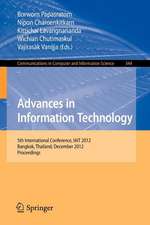Information Systems Transformation: Architecture-Driven Modernization Case Studies: The MK/OMG Press
Autor William M. Ulrich, Philip Newcomben Limba Engleză Paperback – 6 apr 2010
Architecture-Driven Modernization (ADM) restores the value of entrenched systems by capturing and retooling various aspects of existing application environments, allowing old infrastructures to deliver renewed value and align effectively with enterprise strategies and business architectures.
Information Systems Transformation provides a practical guide to organizations seeking ways to understand and leverage existing systems as part of their information management strategies. It includes an introduction to ADM disciplines, tools, and standards as well as a series of scenarios outlining how ADM is applied to various initiatives. Drawing upon lessons learned from real modernization projects, it distills the theory and explains principles, processes, and best practices for every industry.
- Acts as a one-stop shopping reference and complete guide for implementing various modernization models in myriad industries and departments
- Every concept is illustrated with real-life examples from various modernization projects, allowing you to immediately apply tested solutions and see results
- Authored by the Co-chair of the Object Management Group (OMG) Architecture-Driven Modernization (ADM) Task Force, which sets definitive systems modernization standards for the entire IT industry
- A web site supports the book with up to date coverage of evolving ADM Specifications, Tutorials, and Whitepapers, allowing you to remain up to date on modernization topics as they develop
Preț: 289.84 lei
Preț vechi: 426.86 lei
-32% Nou
Puncte Express: 435
Preț estimativ în valută:
55.46€ • 58.32$ • 45.83£
55.46€ • 58.32$ • 45.83£
Carte tipărită la comandă
Livrare economică 10-24 aprilie
Preluare comenzi: 021 569.72.76
Specificații
ISBN-13: 9780123749130
ISBN-10: 0123749131
Pagini: 456
Dimensiuni: 191 x 235 x 25 mm
Greutate: 0.77 kg
Editura: ELSEVIER SCIENCE
Seria The MK/OMG Press
ISBN-10: 0123749131
Pagini: 456
Dimensiuni: 191 x 235 x 25 mm
Greutate: 0.77 kg
Editura: ELSEVIER SCIENCE
Seria The MK/OMG Press
Public țintă
Computer and Information Systems Managers responsible for managing application portfolios and information architecture, Enterprise Architects responsible for defining information architecture and setting strategy for achieving that strategy, Computer Software Engineers who research, design, develop, and test operating systems-level software and, compilers, Business operations professionals seeking ways to make their organizations more adaptable to changing market demands.Cuprins
Part 1 Architecture-Driven Modernization
CHAPTER 1 Introduction to Architecture-Driven Modernization
CHAPTER 2 Modernization Technologies and Services
CHAPTER 3 Modernization Standards Roadmap
CHAPTER 4 Modernization Scenarios
Part 2 Modernization Case Studies
CHAPTER 5 Modernization of the Eurocat Air Traffic Management System (EATMS)
CHAPTER 6 PowerBuilder/4GL Generator Modernization Pilot
CHAPTER 7 Modernization Case Study: Italian Ministry of Instruction, University, and Research
CHAPTER 8 Modernization of Reliability and Maintainability Information System (REMIS) into the Global Combat Support System-Air Force (GCSS-AF) Framework
CHAPTER 9 Federal Agency Case Study: Role of Modernization in a Greenfield Replacement/ COTS Project
CHAPTER 10 Legacy System Modernization of the Engineering Operational Sequencing System (EOSS)
CHAPTER 11 Model-Driven Reverse Engineering of COBOL-Based Applications
CHAPTER 12 Veterans Health Administration’s VistA MUMPS Modernization Pilot
CHAPTER 13 Delta Lloyd Deutschland Data Migration Case Study
CHAPTER 14 MoDisco, a Model-Driven Platform to Support Real Legacy Modernization Use Cases
Part 3 A Guide to Moving Forward with Modernization
CHAPTER 15 Launching and Sustaining Modernization Initiatives
CHAPTER 1 Introduction to Architecture-Driven Modernization
CHAPTER 2 Modernization Technologies and Services
CHAPTER 3 Modernization Standards Roadmap
CHAPTER 4 Modernization Scenarios
Part 2 Modernization Case Studies
CHAPTER 5 Modernization of the Eurocat Air Traffic Management System (EATMS)
CHAPTER 6 PowerBuilder/4GL Generator Modernization Pilot
CHAPTER 7 Modernization Case Study: Italian Ministry of Instruction, University, and Research
CHAPTER 8 Modernization of Reliability and Maintainability Information System (REMIS) into the Global Combat Support System-Air Force (GCSS-AF) Framework
CHAPTER 9 Federal Agency Case Study: Role of Modernization in a Greenfield Replacement/ COTS Project
CHAPTER 10 Legacy System Modernization of the Engineering Operational Sequencing System (EOSS)
CHAPTER 11 Model-Driven Reverse Engineering of COBOL-Based Applications
CHAPTER 12 Veterans Health Administration’s VistA MUMPS Modernization Pilot
CHAPTER 13 Delta Lloyd Deutschland Data Migration Case Study
CHAPTER 14 MoDisco, a Model-Driven Platform to Support Real Legacy Modernization Use Cases
Part 3 A Guide to Moving Forward with Modernization
CHAPTER 15 Launching and Sustaining Modernization Initiatives
Recenzii
"Ulrich and Newcomb's book offers a comprehensive examination of the challenges of growing software-intensive systems. Every system has an architecture, but as the authors explain, it is only by continuous, intentional architectural transformation that one can attend to costs while simultaneously creating a mechanism wherein innovation may flourish.
I enjoyed the many case studies. Every circumstance is unique, but the authors have offered up best practices for systems modernization from their experience. Their focus on architecture as an artifact for governance is sound, but they go far beyond the technical issues and address many of the social and economic practices that help one evolve a good technical architecture.
From the moment one writes a line of code, it becomes legacy, and that legacy accumulates. Whether it becomes a cause of innovation inertia or a source of future value is a factor of how it is continuously modernized." --Grady Booch, IBM Fellow & Chief Scientist, Software Engineering in IBM Research
"Estimates by internationally-known researchers of the worldwide legacy code base is now approaching a half-trillion lines. That only counts so-called "legacy languages" like COBOL--which drive the world. Add in database schemas, configuration files, and legacy data and the amount of hidden data adds up. This "dark information," like the dark matter of the universe, is critical to our understanding of our world, we can't simply ignore it. Our best hope is to update it, bring it into modern systems, and keep it alive and vital. Fortunately, nobody knows the modernization landscape better than Ulrich and Newcomb, and this in-depth, practical guide is indispensable to planners & practitioners faced with the legacy modernization challenge. Architecture-driven modernization is the best hope for "bringing back" legacy applications & information so it can be successfully applied & reused, and this book explains how to plan, develop & manage modernization from every angle." --Richard Mark Soley, Ph.D., Chairman and CEO, OMG
I enjoyed the many case studies. Every circumstance is unique, but the authors have offered up best practices for systems modernization from their experience. Their focus on architecture as an artifact for governance is sound, but they go far beyond the technical issues and address many of the social and economic practices that help one evolve a good technical architecture.
From the moment one writes a line of code, it becomes legacy, and that legacy accumulates. Whether it becomes a cause of innovation inertia or a source of future value is a factor of how it is continuously modernized." --Grady Booch, IBM Fellow & Chief Scientist, Software Engineering in IBM Research
"Estimates by internationally-known researchers of the worldwide legacy code base is now approaching a half-trillion lines. That only counts so-called "legacy languages" like COBOL--which drive the world. Add in database schemas, configuration files, and legacy data and the amount of hidden data adds up. This "dark information," like the dark matter of the universe, is critical to our understanding of our world, we can't simply ignore it. Our best hope is to update it, bring it into modern systems, and keep it alive and vital. Fortunately, nobody knows the modernization landscape better than Ulrich and Newcomb, and this in-depth, practical guide is indispensable to planners & practitioners faced with the legacy modernization challenge. Architecture-driven modernization is the best hope for "bringing back" legacy applications & information so it can be successfully applied & reused, and this book explains how to plan, develop & manage modernization from every angle." --Richard Mark Soley, Ph.D., Chairman and CEO, OMG
